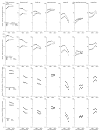US lung cancer trends by histologic type
- PMID: 25113306
- PMCID: PMC4187244
- DOI: 10.1002/cncr.28749
US lung cancer trends by histologic type
Abstract
Background: Lung cancer incidence rates overall are declining in the United States. This study investigated the trends by histologic type and demographic characteristics.
Methods: Surveillance, Epidemiology, and End Results (SEER) program rates of microscopically confirmed lung cancer overall and squamous cell, small cell, adenocarcinoma, large cell, other, and unspecified carcinomas among US whites and blacks diagnosed from 1977 to 2010 and white non-Hispanics, Asian/Pacific Islanders, and white Hispanics diagnosed from 1992 to 2010 were analyzed by sex and age.
Results: Squamous and small cell carcinoma rates declined since the 1990s, although less rapidly among females than males. Adenocarcinoma rates decreased among males and only through 2005, after which they then rose during 2006 to 2010 among every racial/ethnic/sex group; rates for unspecified type declined. Male/female rate ratios declined among whites and blacks more than among other groups. Recent rates among young females were higher than among males for adenocarcinoma among all racial/ethnic groups and for other specified carcinomas among whites.
Conclusions: US lung cancer trends vary by sex, histologic type, racial/ethnic group, and age, reflecting historical cigarette smoking rates, duration, cessation, cigarette composition, and exposure to other carcinogens. Substantial excesses among males have diminished and higher rates of adenocarcinoma among young females have emerged as rates among males declined more rapidly. The recognition of EGFR mutation and ALK rearrangements that occur primarily in adenocarcinomas are the primary basis for the molecular revolution that has transformed lung cancer diagnosis and treatment over the past decade, and these changes have affected recent type-specific trends.
Keywords: cigarette smoking; epidemiology; ethnicity; gender; histology; lung cancer incidence; race; trends.
© 2014 American Cancer Society.
Figures




Comment in
-
Reply to US lung cancer trends by histologic type.Cancer. 2015 Apr 1;121(7):1152-3. doi: 10.1002/cncr.29179. Epub 2014 Dec 2. Cancer. 2015. PMID: 25470011 No abstract available.
-
US lung cancer trends by histologic type.Cancer. 2015 Apr 1;121(7):1150-2. doi: 10.1002/cncr.29180. Epub 2014 Dec 2. Cancer. 2015. PMID: 25470142 Free PMC article. No abstract available.
References
-
- Howlader N, Noone AM, Krapcho M, Neyman N, Altekruse SF, Kosary CL, Yu M, Ruhl J, Tatalovich Z, Cho H, Mariotto A, Lewis DR, Chen HS, Feuer EJ, Cronin KA, editors. SEER Cancer Statistics Review, 1975–2010. National Cancer Institute; Bethesda, MD: Apr, 2013. http://seer.cancer.gov/csr/1975_2010/, based on November 2012 SEER data submission, posted to the SEER web site.
-
- Travis WD, Lubin J, Ries L, Devesa S. United States lung carcinoma incidence trends declining for most histologic types among males, increasing among females. Cancer. 1996;77:2464–2470. - PubMed
-
- Jemal A, Travis WD, Tarone RE, et al. Lung cancer rates convergence in young men and women in the United States: Analysis by birth cohort and histologic type. Int J Cancer. 2003;105:101–107. - PubMed
-
- Devesa SS, Bray F, Vizcaino AP, Parkin DM. International lung cancer trends by histologic type: male:female differences diminishing and adenocarcinoma rates rising. Int J Cancer. 2005;117:294–299. - PubMed
-
- Spitz MR, Wu X, Wilkinson A, Wei Q. Cancer of the lung. In: Schottenfeld D, Fraumeni JF Jr, editors. Cancer Epidemiology & Prevention. 3. New York: Oxford University Press; 2006. pp. 638–658.
MeSH terms
Grants and funding
LinkOut - more resources
Full Text Sources
Other Literature Sources
Medical
Research Materials
Miscellaneous

